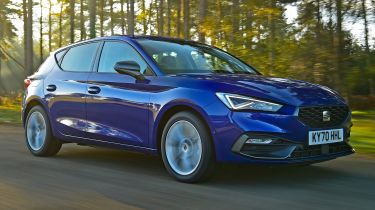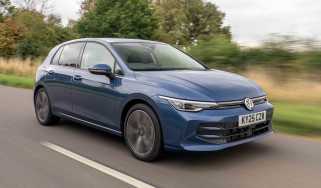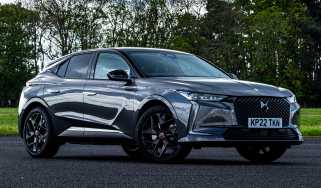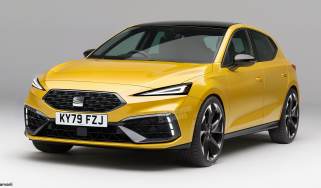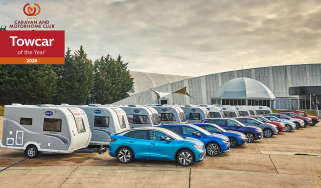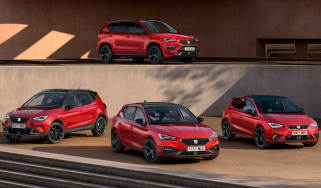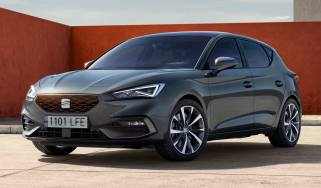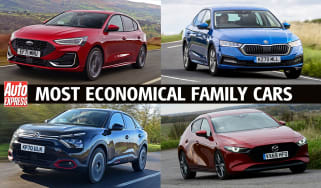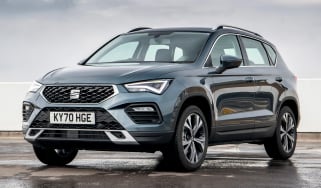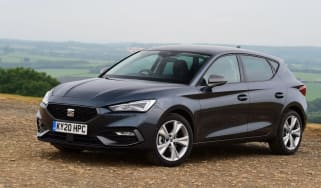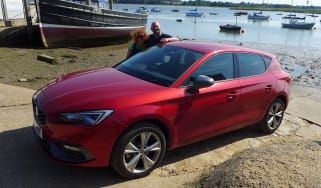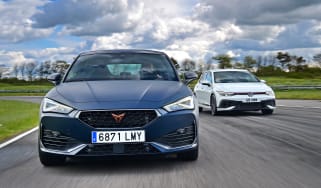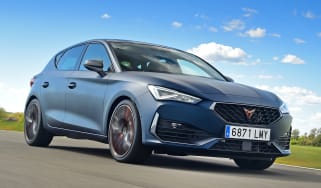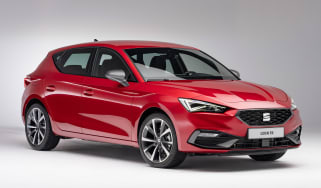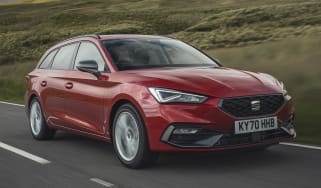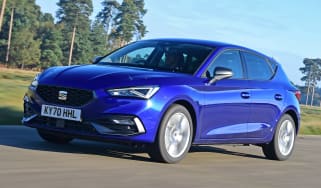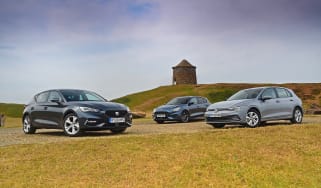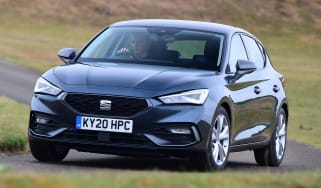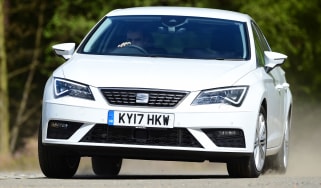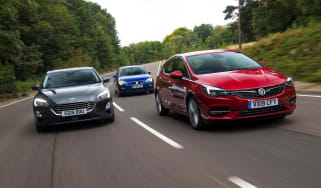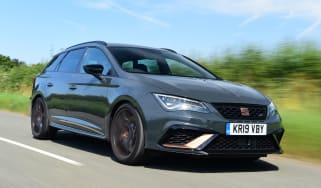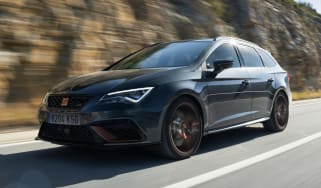SEAT Leon review
The SEAT Leon offers the tech and driving experience of the VW Golf, but for a lower price

The fourth-generation SEAT Leon continues the tried-and-tested formula of taking a Volkswagen Golf and sprinkling it with more adventurous SEAT design. It certainly feels closer to the more expensive Golf in terms of build quality than ever before, and it’s just as good to drive.
The levels of technology and safety are virtually identical between the two as well, and just as important is the fact that there’s significantly more rear space than before, which means it’s perfect for growing families. The boot is a little small for the class, but the Leon is offered as an estate – which is a practical alternative to the Skoda Octavia.
The Golf is more likely to impress your neighbours, and the Ford Focus is nicer to drive, but you’re unlikely to be disappointed with the current Leon.
About the SEAT Leon
The Leon has been a cornerstone of the SEAT range since 1999, when it replaced the Mk2 VW Golf-based Toledo. Since then, SEAT has shifted 2.2 million Leons globally, including around 250,000 in the UK.
The Mk4 Leon is the most advanced and safest version to date. Launched in 2020, it replaced a model that had been on sale since 2012. Like its predecessors, it’s based on the same MQB Evo platform as the VW Golf, which means it’s also closely related to the Audi A3 and Skoda Octavia.
Used - available now
It sits above the Ibiza in the SEAT range, battling for showroom space against SEAT’s trio of SUVs: Arona, Ateca and Tarraco. There’s no three-door version, but a performance version is available in the form of the Cupra Leon. Further competition has arrived since the current Leon went on sale with the Cupra Formentor – which uses the same platform – and the all-electric Cupra Born.
But the Leon's main rivals include the likes of the Volkswagen Golf, Mazda 3, Ford Focus and Vauxhall Astra. It also competes against cars such as the Kia Ceed and Hyundai i30, both of which come with significantly longer warranties as standard.
For the first time, the Leon is available as a plug-in hybrid that offers extremely low running costs and up to 40 miles of pure-electric driving, however you can't order the e-Hybrid version right now. You can still get the Leon with a range of petrol and diesel engines, some with mild-hybrid technology, along with a choice of six-speed manual or seven-speed DSG automatic gearboxes.
The five-door hatchback will account for the majority of sales, but if practicality is important to you then check out the Leon Estate, which comes with 620 litres of boot space compared to the hatchback’s 380-litre boot. In both cases, the plug-in e-Hybrid’s battery pack robs the Leon of boot space.
There are four core trim levels: SE, SE Dynamic, FR and FR Sport, after the Xcellence and Xcellence Lux were discontinued. Standard specification is high, with even SE cars offering 16-inch alloy wheels, LED headlights and rear lights, metallic paint, 8.25-inch touchscreen infotainment system, DAB digital radio, Apple CarPlay, Android Auto, rear parking sensors and cruise control.
SE Dynamic and above get a more impressive 10-inch touchscreen infotainment system and a 10.25-inch customisable SEAT Digital Cockpit. FR and FR Sport models feature lowered and stiffer suspension for a sportier feel.
Leon hatchback prices start from around £23,300 for the SE 1.0 TSI Evo, rising to over £32,000 if you want the more powerful engines in FR Sport trim. Leon Estate prices begin at about £24,700 for the SE 1.0 TSI, while you'll need more than £33,500 for the top-of-the-range model.
Engines, performance and drive
The SEAT Leon is supposedly the sportier version of the Volkswagen Golf, but you’d be hard-pressed to notice the difference. It actually feels much like the old Leon, which is no bad thing.
It has a tighter turning circle than the Golf, which comes in handy when parking, and although visibility out of the back isn’t great, all versions come with rear parking sensors as standard.
On the move, the steering is sharp and direct, while the suspension does a great job of dealing with Britain’s pockmarked roads. Go for the sportier FR models and you’ll notice the lower and stiffer suspension but there isn’t a huge drop off in terms of ride comfort. As is always the case, avoid the larger alloy wheels if you’re after the most comfortable ride.
FR and FR Sport models feature four different driving modes: Normal, Sport, Eco and Individual. This tweaks the throttle response and, on DSG (automatic gearbox) models, alters the gear ratios. Sport mode certainly feels slightly sportier, but Eco mode creates a driving experience that’s akin to swimming through treacle.
0-62mph acceleration and top speed
There are two turbocharged petrol engines: a 1.0-litre TSI Evo and a 1.5-litre TSI Evo. The 1.0-litre three-cylinder engine produces 109bhp and is ideal for drivers who spend most of their time in the city. It’ll hit 62mph in 10.9 seconds with the manual gearbox or 10.8 seconds with the DSG automatic. Top speed is 122mph and 119mph respectively.
The 1.5-litre petrol puts out 128bhp or 148bhp, with the more powerful version available with a seven-speed DSG transmission; this configuration is only offered on the FR and FR Sport. This engine offers the smoothness of a petrol engine with the economy of a diesel. Aside from the plug-in hybrid, it’s also the most rapid, with the 148bhp version hitting 62mph in 8.7 seconds, increasing to 9.4 seconds in the 128bhp version. Pair it with a DSG transmission and it’s marginally quicker to 62mph. Top speed is 135mph for the more powerful version, but 129mph for the lower-powered edition.
The 2.0-litre TDI produces 113bhp and will complete the 0-62mph sprint in 10.2 seconds before hitting a top speed of 124mph. The Leon e-Hybrid is the quickest of the bunch though, with a 0-62mph time of 7.5 seconds and a top speed of 137mph.
MPG, CO2 & running costs
The 113bhp 2.0-litre TDI is the most economical of the regular petrol and diesel engines. It should return 65.4mpg, so it’s ideal for motorway driving.
Not that the petrol engines are in any way inefficient. The 128bhp 1.5 TSI Evo offers 51mpg, dropping to 48.6mpg for the 148bhp model. The seven-speed DSG auto transmission is slightly more efficient than the six-speed manual gearbox.
The 1.0 TSI Evo should return 51.2mpg in both manual and automatic guises in entry-level SE form although in FR guise it drops by 0.3 should you opt for the automatic ‘box. Both the 1.0-litre and 1.5-litre engines are available with 48-volt mild-hybrid technology, but only in conjunction with the DSG.
The Leon e-Hybrid combines a 1.4-litre petrol engine with an electric motor and a 12.8kWh battery pack to make it the greenest SEAT Leon you can buy. Fully charged, the e-Hybrid will deliver up to 40 miles of pure electric range. Thanks to CO2 emissions of just 27g/km to 30g/km, depending on the trim, the plug-in hybrid Leon is also cheap to tax, with Benefit-in-Kind (BiK) rates of as little as eight per cent.
Insurance groups
The SEAT Leon slots into insurance groups 15 to 23, with the 1.0-litre versions the cheapest to insure. The e-Hybrid sits in either group 26 or 27, depending on which trim level is chosen, but the extra cost of cover will be offset by the lower running costs.
Check if your car needs an MoT and view its complete history with our MoT History Checker...
Depreciation
The Leon hatchback performs reasonably well in terms of residual values, holding onto an average of 54 per cent of its original list price after a typical three-year/36,000-mile ownership period, which is even better than the Volkswagen Golf. Both estate models and those fitted with a plug-in hybrid powertrain tend to retain their values best, although it’s fairly even across the range.
To get an accurate valuation on a specific model check out our free car valuation tool...
Interior, design and technology
The previous SEAT Leon was on sale for so long, it had become all too familiar. Unlike with the old car, there’s no three-door version of the current generation, although it’s good that SEAT has resisted the temptation to disguise the rear doors on the new car. It looks great in profile, thanks to some sharp creases and a sloping roofline.
There’s also a neat full-width light bar running across the back of the car, while 16-inch alloy wheels are standard on the entry-level SE model. The FR and FR Sport models are the best looking thanks to larger alloy wheels, LED headlights and sportier bumpers. But it’s a shame about the fake exhausts, you’ll have to splash out on the Cupra's version of the Leon for quad-tip exhausts.
Although the interior of the SEAT Leon isn't quite as sharp looking as the new Golf, it feels more modern and upmarket than its predecessor. It’s a more minimalist approach, with greater emphasis on digital technology.
Quality is excellent, while a neat dashboard design lifts what could otherwise have been a rather sombre cabin. There are some cheap-feeling plastics on the doors and centre console, but the key areas feel good. A flat-bottomed leather steering wheel is standard across the range and is heated on some models.
Leather upholstery was available only on the now-discontinued Xcellence Lux model, although FR Sport-spec cars get a suede upholstery which actually feels more premium. It’s also suitable for buyers looking for a vegan-friendly interior.
Sat-nav, stereo and infotainment
Entry-level SE trim gets an 8.25-inch touchscreen infotainment system with two USB-C ports, seven speakers, DAB digital radio, Bluetooth and steering wheel-mounted controls. All other trims get an impressive 10-inch touchscreen display with sat-nav and voice control. FR models get four USB-C charging ports, a smartphone-charging pad and three-zone climate control while FR Sport feature a heated steering wheel and seats, plus ambient wraparound lighting.
The 10-inch panel in our test car offers very sharp graphics and is quick to respond, but the menu layouts and shortcuts to find different areas might take some getting used to. While it looks like a smartphone's interface, it doesn’t always work quite as intuitively as some of the infotainment systems in this class.
Apple CarPlay and Android Auto are standard across the range and the customisable SEAT Digital Cockpit with a 10.25-inch screen is fitted to all except the SE model. The digital dash looks slick enough, but the panel isn’t as big as some rivals’ and looks a little small under the instrument cowling. However, there’s a good level of customisation when it comes to the data it can show.
Overall, it’s an impressive package, but moving the heating controls to a touch bar below the infotainment screen is a backward step; it’s fiddly to use, especially at night.
Practicality, comfort & boot space
The three-door SEAT Leon is no more, so your choice is limited to a five-door hatchback or Estate. Few will mourn the passing of the three-door Leon SC, not least because SEAT’s family hatchback is more practical than ever before.
Dimensions and size
The SEAT Leon is 4,368mm long and 1,991mm wide, including the door mirrors. This means it’s roughly the same length but slightly narrower than the Volkswagen Golf. The SEAT Leon Estate is 4,642mm long, with the additional length found behind the rear axle.
Leg room, head room & passenger space
SEAT’s designers have added 50mm of extra bodywork between the front and rear axles, which is great news for anyone travelling in the back. That’s because it has been used to create more rear legroom, so the new Leon feels far more spacious than its predecessor.
There’s also lots of headroom, so two adults can sit in the back without having to tilt their heads. Even anyone travelling in the middle will have little cause for complaint, although they’ll have to stick their feet either side of the hump in the floor.
The rear doors are larger than before, so it’s easier to get in and out. This is also handy when loading a child into a car seat – there are two ISOFIX mounting points in the back.
Up front, the driver and front seat passenger will find plenty of headroom and shoulder room, while there’s plenty of adjustment in the driver’s seat and steering wheel. Everyone should be able to find their ideal driving position. The minimalist design makes it feel even more spacious and there are plenty of useful storage areas throughout the interior.
Boot space
The Leon’s 380-litre luggage capacity is below average for the class but just a litre shy of the VW Golf’s. The location of the battery means the capacity drops to 270 litres in the e-Hybrid model (pictured above), which is a figure you’d associate with a supermini, rather than a family hatchback. If you need more space, it would be worth considering the Skoda Octavia hatchback with its massive 600-litre boot.
There’s a large load lip, which can make loading heavy items a bit of a pain, and there are none of the clever storage solutions you might find in a Skoda. The only exciting feature is the virtual pedal on the Xcellence Lux model, which provides hands-free access to the boot.
For something more practical, the SEAT Leon Estate features a 620-litre boot, although the luggage capacity drops to 470 litres in the e-Hybrid version.
Towing
The 2.0-litre diesel has a maximum braked towing capacity of 1,800kg, which makes it the pick of the range for anyone intending to tow a caravan or trailer. The 1.4-litre petrol versions will tow up to 1,700kg, but the figure drops to 1,500kg for 1.0-litre models.
The Leon Estate won the caravan weight 1,100-1,200kg class at the 2020 Caravan and Motorhome Club Towcar of the Year Awards.
Reliability and safety
In 2022, the SEAT Leon finished in a creditable 29th place on our list of the best cars to own based on that year's Driver Power owner satisfaction survey results. In 2023 however, the Leon didn't make it on the list and neither did its VW Golf sibling. Meanwhile, SEAT came 23rd in our best car manufacturer rankings – four places ahead of Volkswagen.
Euro NCAP tested the SEAT Leon in 2020, awarding it a maximum five-star safety rating. The individual scores were impressive. It scored 92 per cent for adult occupant protection and 88 per cent for child occupant protection, with 71 per cent for vulnerable road user protection and 80 per cent for safety assist technologies.
All models get cruise control with speed limiter, a forward-collision warning system for vehicles, pedestrians and cyclists, lane-keeping assist, ISOFIX anchor points in the back and rear parking sensors.
The Leon is the safest car SEAT has ever built. It features a Safety & Service system as standard, which contacts the emergency services in the event of an accident. If the occupants cannot respond, the car sends details of the car’s position, type of engine, body colour and the number of passengers.
Keyless start is also standard, while some models also feature keyless entry. Also available are blind spot detection, adaptive cruise control, auto high beam, dynamic road sign display and even semi-autonomous vehicle control in an emergency.
Warranty
The SEAT Leon comes with a three-year/60,000 mile warranty, which is standard for this class. This can be extended to four years and 75,000 miles or five years and 90,000 miles. Extended warranties cost extra, but the cover can be transferred to the next owner. Alternatively, rivals from Kia and Hyundai are covered for seven and five years respectively.
Servicing
SEAT offers fixed-price servicing plans, or you can pay for scheduled maintenance on a more flexible monthly basis.

